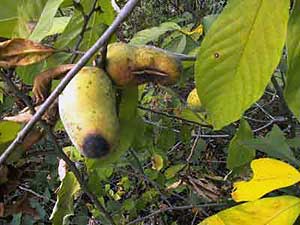 Pawpaws
(Asimina triloba) like it moist. The small trees, 9 to 30 feet
tall, grow along streams, in bottoms, and at the base of bluffs. You
will usually find several of them together because they put up shoots
that grow into more pawpaw trees close by. They also grow easily from
their big black seeds. You can recognize pawpaws by their green droopy
leaves which are 6 to 10 inches long and stay green after other trees
have changed color. Pawpaws
(Asimina triloba) like it moist. The small trees, 9 to 30 feet
tall, grow along streams, in bottoms, and at the base of bluffs. You
will usually find several of them together because they put up shoots
that grow into more pawpaw trees close by. They also grow easily from
their big black seeds. You can recognize pawpaws by their green droopy
leaves which are 6 to 10 inches long and stay green after other trees
have changed color.
Pawpaws are members of the Custard Apple plant family of tropical
fruits. Like custard apples, they have soft custard-like flesh with
lots of seeds in it. Pawpaws taste tropical. At its best pawpaw
tastes like mango, but its flesh is more like ripe banana.
They flower from March to May, with their dark maroon flowers.
These dark flowers don't seem to attract many pollinators, since
most pawpaws don't set fruit. If you have a bunch of pawpaw trees,
you might try hand-pollinating them so that they will set more fruit.
When a flower does set fruit, it has quintuplets --- five at once!
Over the summer, one or more of these usually drop off, usually
leaving just one or two to pick in late August or September.
They can be hard to spot, hidden by leaves. They can be up to 6
inches long and 3 inches thick and weigh a pound. You have to let
them ripen in order to taste them at their best or else they taste
bland. The trick is to pick them before the raccoons or opossums
do. Or before a wind storm sends them to the ground. It's best to
pick them just as they start to soften, and put them in the refrigerator
for two or three weeks to let them ripen there.
You'll probably want to eat your pawpaw outside or someplace where
you can make a mess, spit out the seeds, and then wash off. If you
try to cut one open with a knife, you'll hit the black seeds, like
big lima beans. Best to skin it and then go for it!
|

